How to Can Your Own Tomatoes
Oct 27, 2011, Updated Sep 20, 2018
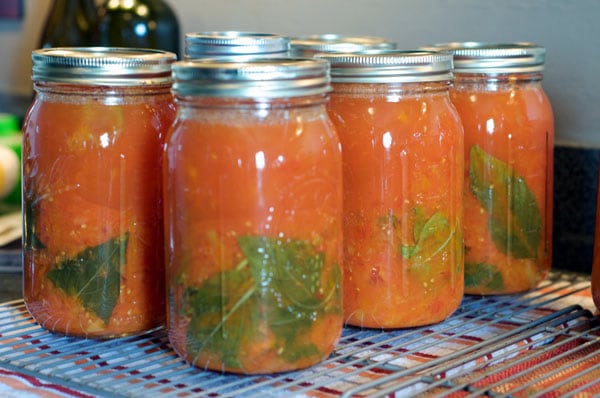
Over the course of the past several years, DPaul and I have steadily backed away from packaged foods, always striving to get closer to whole ingredients as a base. Consequently, it’s compelled us to do a lot more canning. Now, this is something of an unprocessed grey area in our kitchen, as I do use refined white sugar in my jams and pickles, but I figure at least this way I’m still managing the amount of it in our diet. A weak justification, perhaps, but it works for me. And anyway, we simply don’t eat that much jam (which is why we have a closet full of the stuff, mainly given to us by others.)
But perhaps the biggest departure from dependence on processed foods is with tomatoes. I’m half Italian, and so tomatoes are more to me than an ingredient; they’re as basic as water and air to my existence. (Mind you, we’re not eating so much pasta these days, either, but that’s another post.) So, for the last four years, we’ve been canning our own, and a lot of them at that. We’ve settled into a groove of canning 100 pounds each year. We’ve dabbled with different tomatoes, and this year chose to do 100% San Marzanos from Mariquita Farm. San Marzano and other plum-type tomatoes tend to have more flesh and less water, so you’ll get a better yield. Keep the heirlooms for salads and sandwiches.
Now, it’s true that off-the-shelf, canned tomatoes are as close to unprocessed as processed foods go. If you read the labels, it’s not hard to find purees or crushed tomatoes that contain nothing more than tomatoes and citric acid, and Muir Glen’s are even organic. However, most cans in America are lined with BPA, a known endocrine disruptor and possible carcinogen. (Standard canning lids also have BPA, but the contact between the lid and home-canned foods is minimal, so there’s negligible exposure.) But there’s another factor to consider: As outlined in Barry Estabrook’s Tomatoland, commodity tomato production is one of the greatest agents of human slavery in America today. Migrant workers are lured over the border with the promise of work, only to find that the pay is insufficient to cover the debt they incur in the process. I prefer my tomatoes not to have the bitter aftertaste of human misery, thanks.
Here’s the thing with tomatoes: They are just at the threshhold of safe acidity levels for water bath canning. That means that depending on your tomato’s soil, variety, ripeness, and other factors, it may not be safe, and there’s no way to know. The most common way to work around this is to acidify them by adding two tablespoons of bottled lemon juice or 1/2 teaspoon of citric acid to each quart prior to canning. Citric acid in its pure form is almost certainly not in Unprocesed territory, and bottled lemon juice contains nasty preservatives like sodium benzoate, sodium sulfite and sodium metabisulfite. Luckily, it turns out that real lemons, so long as they’re Lisbons or Eurekas (not meyer), are sufficiently acidic, so squeeze on.
That said, I want my tomatoes to taste like tomatoes, not lemon, so we go the other route: Pressure canning. This way we can put nothing other than tomatoes in our jars, and have a blank canvas to work with then we crack them open down the line. The National Center for Home Food Preservation also recommends it for higher quality and better nutrition, so hooray for us. (But here’s what to do if you don’t have a pressure canner.)
When you’re taking on a canning project, it pays to think ahead and set up your workflow. For tomatoes, our process is core, score, blanch and shock, peel and seed, crush and cook, can.
Core
With a paring knife, carefully cut out a cone shape around the stem end of the tomato. For 100 pounds of tomatoes, you will do this approximately 10,000,000 times.
Score
Cut a small X in the opposite end of the tomato. This will help the skin to peel away after blanching.
Blanch and Shock
Have a large stockpot of water simmering, and fill a cooler with ice water. Carefully lower tomatoes into the water in batches, and simmer for about 30 seconds, or until the skin begins to wrinkle or peels away at the cored and scored ends. Remove the tomatoes to the ice water to stop cooking. Keep plenty of ice, like a few bags, on hand to replenish your shock bath.
Peel and Seed
Place a colander or strainer over a large pot or roasting pan. Remove the tomatoes from the water. The skins should slide off easily. With your thumbs, pry open the segments of the tomatoes from the cored end and pull out the seeds. Leave the skins and seeds in the colander, and reserve the liquid in the pot. The skins and seeds can be composted, or reserved and blended into a paste. The tomato water can be canned separately and used as a base for soups, braises … and cocktails. Before long, your hands will look like this.
Crush and Cook
Crush the skinned, seeded tomatoes directly into a large stockpot, and place over a medium flame. Bring the tomatoes to a simmer, stirring to keep from scorching or sticking. The tomatoes will break down; feel free to use an immersion blender if you want a smoother puree.
Can and Process
Have sterilized, hot jars waiting and have your pressure canner with the appropriate amount of water simmering. We typically run them through the dishwasher, timed to be done shortly before we’re ready to pack. Otherwise, keep your sterilized jars in a 220ºF oven. Ladle the hot tomatoes into hot jars (optional: add a sprig of basil). Run a clean chopstick or spatula around the periphery of the interior of the jars to release any trapped air. Wipe the rims with a clean, moist towel to ensure good contact with the lid. Add the lids and screw on the rings until just finger-tight.
Lower the jars into the canner. Apply the top of the canner and lock in place; remove the petcock from the valve. Crank up the heat on the stove to high. Once steam is venting consistently from the valve, set the timer for 10 minutes. Then, place the petcock on the valve and build pressure. Start backing the heat down when you reach 8 PSI; your goal is to hit and maintain just slightly above 11 PSI, and you don’t want to overshoot too much. As soon as the gauge reaches 11 PSI, set the timer for 15 minutes (at sea level; see recommendations for other elevations). If the pressure continues to build, gently lower the heat until it stabilizes. If the gauge ever dips below 11 PSI, though, bring it back up and start your timer over. You need 15 uninterrupted minutes at pressure.
Once the 15 minutes is up, turn off the heat. And wait. The canner must come down to normal pressure on its own; this will take about 30-45 minutes. When the pressure has dropped and the canner can be opened, remove the lid and let the jars stand for another 10 minutes. Then, removed them to a cooling rack, where they will bubble like lava lamps for another few hours.
After 12-24 hours, remove the rings and check the seals. The lid should be concave, and you should be able to lift the entire jar from the lid. If any lids did not seal, keep those jars in the refrigerator for more immediate use, or you can go through the entire process again for those. This year, we had about a 30% fail rate on lids, so I reprocessed almost a third of our tomatoes the following day.
Sure, it’s grueling, backbreaking, sweaty work, but one day’s effort pays off with a year’s worth of tomatoes.
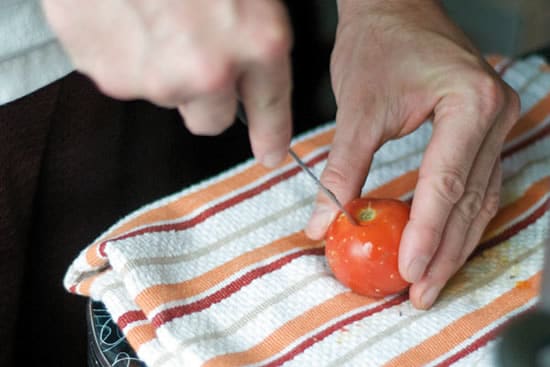
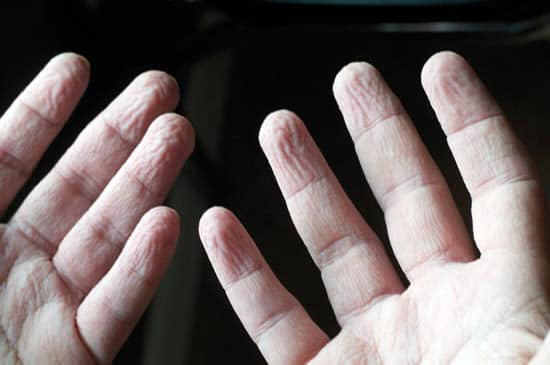
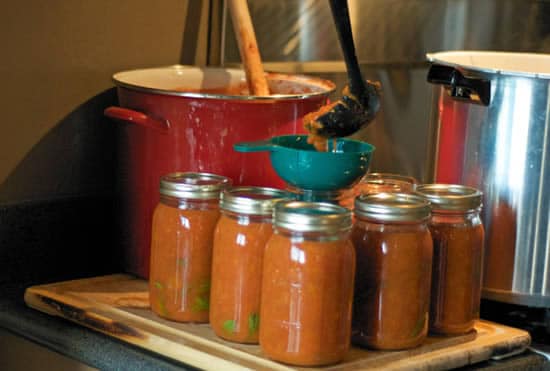

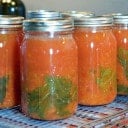

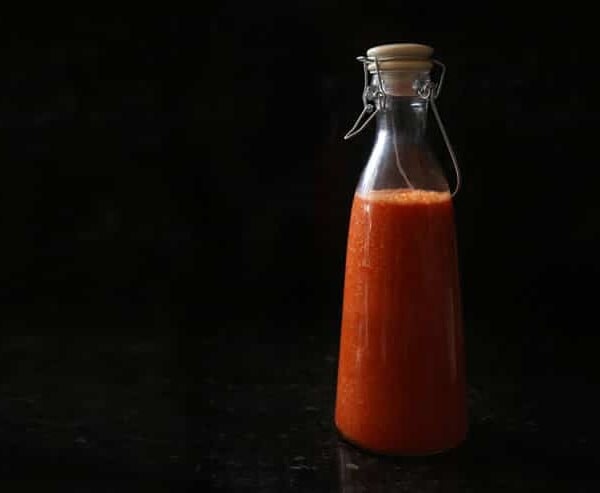

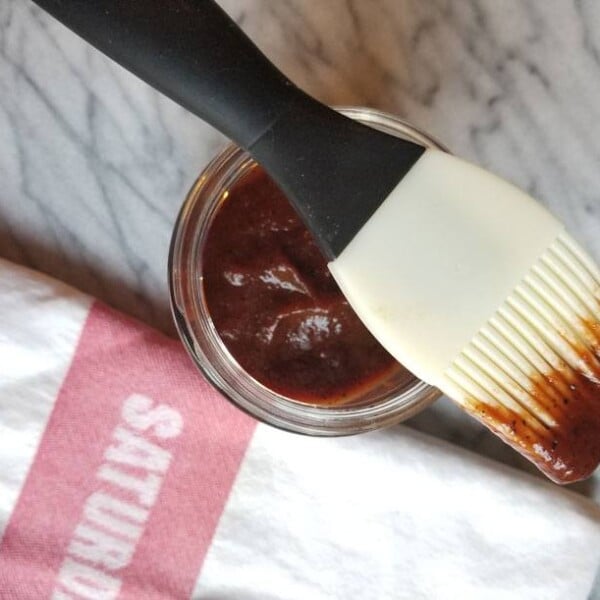
















I was glad to see that you pressure canned your tomatoes.
For those that don’t have a pressure canner, you can check with your county agriculture center and they may have a kitchen center you can use. You’d be surprised at what the AG centers offer it’s residents. It’s wonderful to have commercial equipment to do big jobs like this!
Wow, I am so impressed with everyone’s canning knowledge!
I’d love to can someday. Perhaps I’ll try a small batch with the water bath with added lemon.
Gosh, as I type this I have my first batch ever of home-canned tomatoes sitting in the boiling water doing their thing! My kitchen is a mess, but if they come out even half as well as this summer’s peach jam, it’ll be worth it.
I had to laugh at “one day’s grueling work equals a year of tomatoes.”. I am a mom of 4, and have canned my own tomatoes for 17 years. Even with help, I can’t do 75 quarts of tomatoes in one day!! That said, the flavor and quality of my home- canned tomatoes is totally worth all the effort. I buy maybe 3 tomatoes all winter because what comes out of the bottle is so much better.
I am trying to figure out why you had such a high failure rate. Not for any other reason than that it is bothering me. I have not had a seal fail yet (two years, about 300 lbs of tomatoes).
How much head space are you leaving?
I was wondering about that too. I haven’t had a seal failure in the last 3 years, and I keep a sharp eye on the very few jars that don’t ping by the 10 minute mark. Fortunately those couple jars sealed by the 15 minute mark. Disclosure – I can at altitude.
-the redhead-
I’ve had a lot of conversations with folks, and increasingly I’m hearing similar stories — especially on the West Coast. Some of us think that there’s a QC problem with Ball/Jarden and batches of lids on this side of the country are subpar. I know several people who routinely have a 30-35% fail rate with both water bath and pressure canning here.
I was wondering the same thing! I canned DOZENS of jars this summer, wide mouth & regular & had not one single lid not seal. Most of them popped within 10 minutes! That’s craziness. I’d be contacting the manufacturer about that & asking for a 30% refund!
The only thing you left out was when you remove the lid from the pressure cooker, make sure to remove it in a way that the edge closest to you goes over the pot, and you tip it so the hot condensation on it runs back into the pot. You only have to have that drip onto your protruding post baby belly once to regret not thinking of that before.
Great tip!
-the redhead-
Oh lord, thanks for that — so true. I can hardly count the number of times I’ve scorched myself opening the lid.
Any advice on freezing tomatoes? I don’t have the canning equipment, perhaps next year.
Paula, I freeze tomatoes.
Last year, I froze them whole/raw, only cutting out the stem & any “bad” parts. Then I single layered them on a metal baking sheet in the freezer. Once individually frozen, I transferred to large freezer bags. It’s easy to defrost, and if you don’t like the peels, they can be rubbed off very easily as they defrost. I don’t mind the peels, but the texture does get watery, but if you are making sauce, it’s all good.
This year, I roasted all my tomatoes first, then froze in freezer bags. Make sure to lie the bags flat on a baking sheet, so they stack nice and neat once frozen. We’ll see how they compare. I’m sure didn’t freeze as much as I’ll need, but there is always next season.
We had a few people post on freezing tomatoes: http://www.punkdomestics.com/category/tags/freezing-tomatoes
Excellent article. I’m slowly migrating to organic, including a backyard with raised gardens. I am absolutely sickened by what i’m learning about our food.
I use organic evaporated cane juice in my canning & jamming. As I said in my blog “Local organic ingredients & being home made trumps using sugar every time in my book. The jams & preserves I make are certainly far less processed than anything at the store. I +know+ where the fruit comes from, and have often had lovely chats with the growers on Saturday mornings at the market. Some of my ingredients come from folks I know well. They include a bit of Colorado summer and my own elbow grease – how can you beat that? I feel my preserves fit the spirit of the October Unprocessed Challenge well.” I didn’t do tomatoes this year, but may indulge in some sauce next year. Thanks for the step by step regarding the pressure method. I can water bath can in my sleep, but haven’t quite made the leap yet.… Read more »
Great post. I hope to get more serious with tomatoes next season. Any tips on identifying Lisbon or Eureka lemons? I can spot a Meyer, but that’s it.
Apologies for not replying sooner — was traveling. Basically, your standard lemons, the ones that are obviously not Meyers, are either Lisbons or Eurekas. There aren’t any other varieties that are widely commercially available.